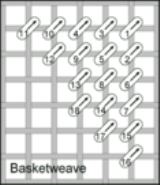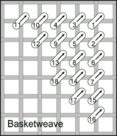
Tent stitch
Encyclopedia
Tent stitch is a small, diagonal embroidery stitch
that crosses over the intersection of one horizontal (weft) and one vertical (warp) thread of needlepoint canvas
forming a slanted stitch at a 45-degree angle. It is also known as Needlepoint stitch and is one of the most basic and versatile stitches used in Needlepoint
and other Canvas work
embroidery. When worked on fine weave canvas over a single warp and weft thread it is known as Petit point in contrast to stitches, such as Gobelin
, worked over multiple warp and/or weft threads.
"Petit point" comes from the French language
, meaning “small point”.
 There are three types of tent stitch, all producing the same appearance on the front of the canvas but each worked in a slightly different way and having particular characteristics, uses, benefits and drawbacks. These variants of tent stitch are known as basketweave, continental and half cross tent stitches:
There are three types of tent stitch, all producing the same appearance on the front of the canvas but each worked in a slightly different way and having particular characteristics, uses, benefits and drawbacks. These variants of tent stitch are known as basketweave, continental and half cross tent stitches:
Embroidery stitch
In everyday language, a stitch in the context of embroidery or hand-sewing is defined as the movement of the embroidery needle from the backside of the fabric to the front side and back to the back side. The thread stroke on the front side produced by this is also called stitch...
that crosses over the intersection of one horizontal (weft) and one vertical (warp) thread of needlepoint canvas
Canvas
Canvas is an extremely heavy-duty plain-woven fabric used for making sails, tents, marquees, backpacks, and other items for which sturdiness is required. It is also popularly used by artists as a painting surface, typically stretched across a wooden frame...
forming a slanted stitch at a 45-degree angle. It is also known as Needlepoint stitch and is one of the most basic and versatile stitches used in Needlepoint
Needlepoint
Needlepoint is a form of counted thread embroidery in which yarn is stitched through a stiff open weave canvas. Most needlepoint designs completely cover the canvas...
and other Canvas work
Canvas work
Canvas work is a type of embroidery in which yarn is stitched through a canvas or other foundation fabric. Canvas work is a form of counted-thread embroidery...
embroidery. When worked on fine weave canvas over a single warp and weft thread it is known as Petit point in contrast to stitches, such as Gobelin
Gobelin
Gobelin was the name of a family of dyers, who in all probability came originally from Reims, and who in the middle of the 15th century established themselves in the Faubourg Saint Marcel, Paris, on the banks of the Bièvre....
, worked over multiple warp and/or weft threads.
"Petit point" comes from the French language
French language
French is a Romance language spoken as a first language in France, the Romandy region in Switzerland, Wallonia and Brussels in Belgium, Monaco, the regions of Quebec and Acadia in Canada, and by various communities elsewhere. Second-language speakers of French are distributed throughout many parts...
, meaning “small point”.
Tent stitch variants

- Basketweave tent stitch
The basketweave form of tent stitch is worked in diagonal rows up and down the canvas. The yarn on the back of the canvas has a typical basketweave appearance, with alternating horizontal and vertical stitches. Basketweave is the best stitch to use for covering large areas of canvas as it does not distort the canvas as the other two forms of tent stitch do.
- Continental tent stitch
Continental stitch is worked horizontally or vertically across the canvas. On the back of the work, the stitches appear diagonally across two threads. This method uses more yarn than half cross stitch tent stitch but is more hardwearing.
- Half cross tent stitch
Half cross stitch is worked horizontally or vertically across the canvas. On the back of the work, the stitch appears vertical or horizontal, not diagonal, and crosses only one thread. This method uses less yarn than other stitches but is not very durable as coverage on the back of the canvas is a little thin.

